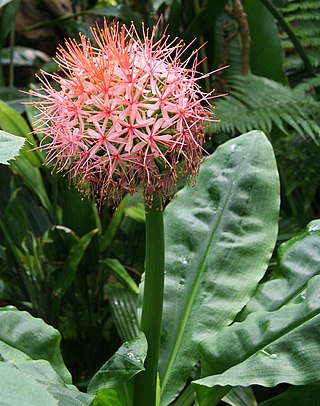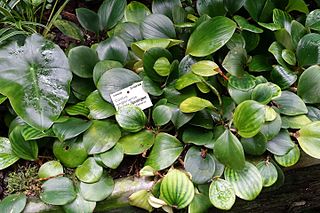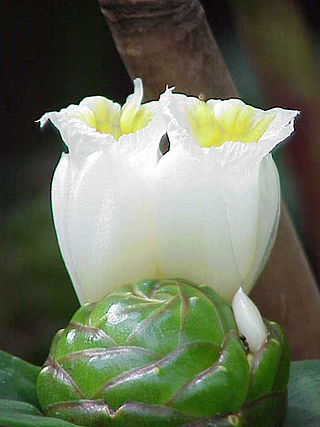
The Zingiberales are flowering plants forming one of four orders in the commelinids clade of monocots, together with its sister order, Commelinales. The order includes 68 genera and 2,600 species. Zingiberales are a unique though morphologically diverse order that has been widely recognised as such over a long period of time. They are usually large herbaceous plants with rhizomatous root systems and lacking an aerial stem except when flowering. Flowers are usually large and showy, and the stamens are often modified (staminodes) to also form colourful petal-like structures that attract pollinators.

Zingiberaceae or the ginger family is a family of flowering plants made up of about 50 genera with a total of about 1600 known species of aromatic perennial herbs with creeping horizontal or tuberous rhizomes distributed throughout tropical Africa, Asia, and the Americas. Many of the family's species are important ornamental, spice, or medicinal plants. Ornamental genera include the shell gingers (Alpinia), Siam or summer tulip, Globba, ginger lily (Hedychium), Kaempferia, torch-ginger Etlingera elatior, Renealmia, and ginger (Zingiber). Spices include ginger (Zingiber), galangal or Thai ginger, melegueta pepper, myoga, korarima, turmeric (Curcuma), and cardamom.

Costaceae, known as the Costus family or spiral gingers, is a family of pantropical monocots. It belongs to the order Zingiberales, which contains horticulturally and economically important plants such as the banana (Musaceae), bird-of-paradise (Strelitziaceae), and edible ginger (Zingiberaceae). The seven genera in Costaceae together contain about 143 known species. They are native to tropical climates of Asia, Africa, Central America, and South America. Several species are frequently found in cultivation.

Costus is a genus of herbaceous perennial plants in the family Costaceae, erected by Linnaeus in 1753. It is widespread through tropical and subtropical regions of Asia, Africa, and the Americas.
Paulus Johannes Maria "Paul" Maas is a botanist from the Netherlands and a specialist in the flora of the neotropics. Maas has identified and named about two hundred fifty plants from the Burmanniaceae, the Costus Family (Costaceae), the Gentian Family (Gentianaceae), the Bloodwort Family (Haemodoraceae), the Banana Family (Musaceae), the Olacaceae, the Triuridaceae, and the Ginger Family (Zingiberaceae).

Cheilocostus speciosus, or crêpe ginger, is a species of flowering plant in the family Costaceae. Some botanists have now revived the synonym Hellenia speciosa for this species.

Renealmia is a plant genus in the family Zingiberaceae. Its members are native to tropical Africa and tropical America. In Peru, fruits and tubers are sources of indigenous dyes. and indigenous medical treatments for leishmania and malaria In Colombia, it is used to treat snakebite. Bracts and leaves can serve as phytotelmata, retaining small quantities of water that offer habitat for other organisms.

Hillegonda (Hiltje) Maas-van de Kamer is a botanist at the Institute of Systematic Botany at Utrecht University. She is the wife of Professor Paul Maas and together they have published many papers. She is a specialist in the flora of the neotropics.

Costus osae is a species of flowering plant in the family Costaceae. One of many rare tropical plants in the Costus family, Costus osae is a species native to Costa Rica described in 1997. It has also been reported from Colombia.

Costus spicatus, also known as spiked spiralflag ginger or Indian head ginger, is a species of herbaceous plant in the Costaceae family.

Scadoxus cinnabarinus is a herbaceous plant from tropical rainforest in Africa. It is native to Western and Central Africa from Sierra Leone in the far west to Angola in the south. It has been reported from Ghana, Côte d'Ivoire, Nigeria, Niger, Sierra Leone, Central African Republic, Cameroon, Congo, Equatorial Guinea, Gabon, São Tomé, Zaire, Uganda, and Angola.

Dimerocostus is a group of flowering plants in the Costaceae described as a genus in 1891. It is native to Central and South America.

Paracostus is a group of plants in the family Costaceae described as a genus in 2006. It is native to Borneo and to tropical Africa.
Costus curvibracteatus is a tropical rhizomatous perennial native to Costa Rica and Panama.

Costus woodsonii, the red button ginger or scarlet spiral flag, is a species of flowering plant in the family Costaceae, native to Nicaragua, Costa Rica, Panama, and Colombia. A rhizomatous geophytic perennial, it is recommended for coastal gardens, borders, containers, and general wet, tropical garden applications. It is more widely cultivated than other species of Costus. Costus woodsonii is named for Robert Woodson of the Missouri Botanical Garden.

Costus pulverulentus, the red cigar or spiral ginger, is a species of flowering plant in the family Costaceae. It is native to Mexico, Central America, Colombia, Venezuela, and Ecuador, and it has been introduced to Cuba and Florida. It is invasive in Hawaii.

Costus dubius is a species of plant native to Tropical Africa.

Costus afer, English ginger lily or common ginger lily, is a species of plant native to Tropical Africa.
Costus scaber is a species of plant in the Costaceae family. Its native range is Mexico to Tropical America.

Costus productus, known as Orange Tulip Ginger, Dwarf Orange Ginger, or Green Mountain Spiral Flag, is a species of plant in the Costaceae family. Costus productus is native to South Colombia and Peru.
















